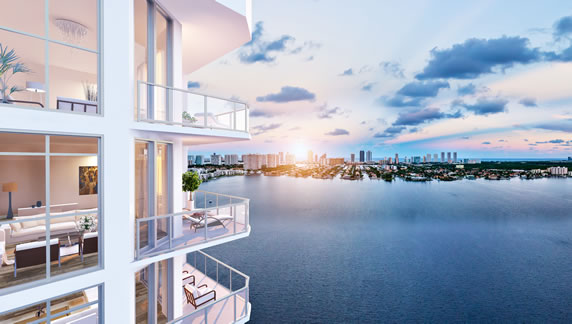
Miami’s Marina Palms Yacht Club & Residences – a new luxury condominium development with a full-service yacht club, has sold out its north tower and is now unveiling a second tower. Located at 172nd Street and Biscayne Boulevard in North Miami Beach, when complete the development will provide one million square feet of luxury residential space situated in two towers sitting on a 14-acre waterfront site. Each of the two towers will consist of 234 spacious residences, which will be complemented by a full-service marina with 112 slips capable of mooring yachts up to 90 feet in length. Rendering courtesy of The Plaza Group
“Cities are becoming the place to be,” says Gary Pomerantz, executive vice president at WSP Group. “If you’re going to bring local wealth back into the cities from the suburbs, you have to offer something as luxurious as what can be found in a single-family home with acres of land and beautiful views.”
[pullquote]If you’re going to bring local wealth back into the cities from the suburbs, you have to offer something as luxurious as what can be found in a single-family home with acres of land and beautiful views.[/pullquote]Residential high-rises used to be reserved for affordable housing, but that perception has changed in the last decade. “People are realizing what can be done with high-rise buildings, and they want this luxury lifestyle,” says Bill Campbell, vice president of sales and marketing at Campbell Property Management. “Years ago, developers built square blocks. Today, with the architecture and technology we have available, high-rise homes are totally different. Nothing existed years ago like the stuff I see today – and the tenants like it.”
Campbell also points out that many luxury high-rise tenants don’t live in these buildings year-round. “When they get away, they’re looking for extravagance – a place that’s fully maintained and fully secure, with surroundings that are very special.”
Kobi Karp, owner of Kobi Karp Architecture and Interior Design, says most of his firm’s luxury high-rise multifamily work is urban infill. “These high-rises are basically a luxury product within a community; tenants want the luxury product, but the location is immediately adjacent to non-luxury product.” In South Beach and Miami – two areas with booming luxury high-rise markets – Karp says several luxury projects are being located near affordable housing, electrical power stations, or even funeral homes. “People are choosing the luxury product because the location is good,” he explains. “But it isn’t necessarily a location that is exclusively for all luxury high-rises.”
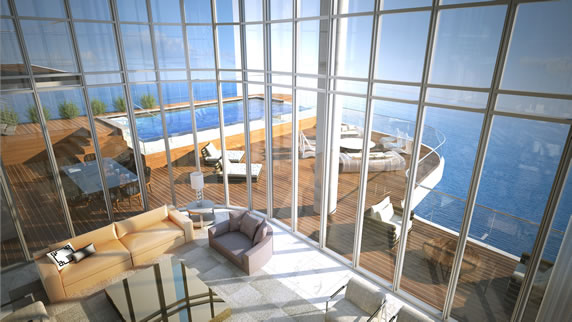
Construction on the Chateau Beach Residences is underway in Sunny Isles Beach, Florida. The 33-story tower will have 84 luxury units, varying from two to five bedrooms, and a penthouse with a private swimming pool. According to the developer, the property’s tower, which rises from an elevated podium, incorporates the “organic curves of the nearby beach dunes and its crystalline window walls echo the luminosity of the waves of the ocean it overlooks.” Rendering courtesy Château Group
An Eye on Security
Security technology that used to only be seen in Hollywood movies, is making its way into luxury high-rise real estate. As a tenant approaches the building’s entrance, digital infrared cameras with sensors grant or deny access based on retina scans. By looking directly into the high-tech camera, the sensors can recognize who is (and isn’t) cleared to enter the property.
Once the tenant is inside, more biometric screening technology is required before access is granted to the building lobby. But the discrete technology doesn’t inconvenience tenants by requiring keys or card swipes. Some luxury high-rises offer private elevators that take each tenant directly to the appropriate unit. In buildings with shared elevator cabs, tenants typically only have access to their floor. Another sensor recognizes the tenant before access is granted to the elevator or the unit itself. This same biometric technology is often incorporated into the adjoining parking garages and mailbox areas.
“It’s very common technology that’s even being used by U.S. Homeland Security’s Global Entry program,” says Karp. “It’s not expensive, but the issue is maintenance and operation. If it’s connected properly to a local system, then you’re in pretty good shape. If not, it can be difficult to manage.” Issues such as false negatives (valid individuals being prevented from entering) can hinder productivity. False positives can grant unauthorized access to the building. Security of the computers hosting the application and the biometric databases is also key. The computers, networks, and equipment used in the authentication process need to be secure, and should be monitored continuously.
While this new security technology is being implemented in luxury high-rises to increase tenant satisfaction and reduce man hours, Campbell says that tenants often expect someone to be at the front desk to greet them and their neighbors, and act as a concierge service.
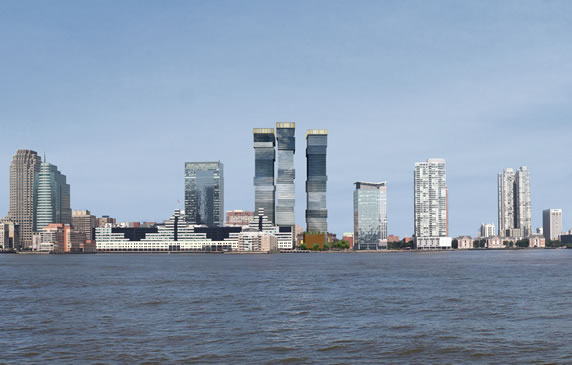
Mack-Cali Realty Corporation and its joint venture partner, Ironstate Development Company, broke ground recently on URL Harborside, a 69-story, 763 unit, high-rise residential tower in Jersey City, New Jersey. According to the developer, URL, which stands for Urban Ready Living, is a direct response to the desires of those looking to live in apartments that use less energy, provide more innovative spaces, and offer public areas that foster community. The $291 million development, the first phase of URL Harborside which will ultimately feature three towers comprising 2,358 residences overlooking the Manhattan skyline, is expected to be completed in mid-2016. Rendering courtesy Ironstate Development
Going with the Flow
When it comes to heating and cooling, Pomerantz says everything is becoming concealed in the ceiling. With variable refrigerant flow (VRF) systems that offer four or five fan coils, there are no noisy compressors in the units. “Everyone’s got great home theater systems now, and not only do tenants want to see the picture on the big screen, but they want to hear it,” he emphasizes. “If you hear the growling noise in the background because of the AC equipment, it just doesn’t work.”
Individual HVAC control is important also, but Pomerantz says that it’s becoming increasingly necessary to be able to control the systems through a handheld mobile device, no matter the tenant’s location. To ensure that cell phones and devices actually work when you’re 200 or 300 feet in the air, reinforcing cellular communications within the building not only ensures that tenants have the phone and data service they need, but also ensures that they can control their unit’s mechanical systems.
The building’s height can also cause water pressure that tenants and facilities staff may not be used to. “You have to educate your team on things like high-pressure water systems. System design is important, but the systems have to be maintained correctly. There’s a certain respect that goes along with high-pressure systems,” explains Pomerantz. As he explains, 300 or 400 pounds per square inch in the pipe will knock someone off of a ladder if a valve is opened.
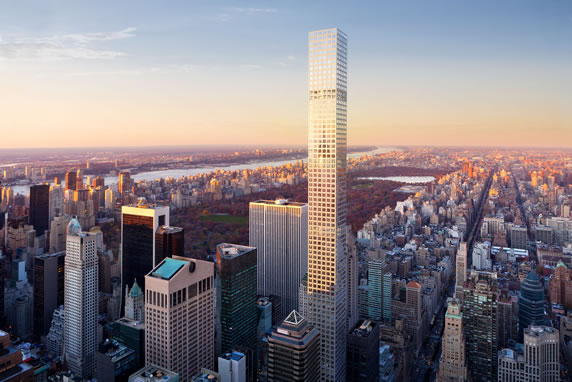
84-story 432 Park Avenue in New York City, which is under construction, has sold about $1 billion worth of units according to L.A.–based real estate investor, CIM Group, who is developing the property in partnership with Macklowe Properties. The 1,398-foot-tall tower houses 126 condominium apartments ranging in price from $7 million to $95 million. Harry Macklowe told the New York Times that total sales are expected to surpass $3 billion compared to about $1.25 billion in construction costs. About half the buyers are foreigners according to Macklowe, primarily from Asia. Rendering courtesy dbox for CIM Group & Macklowe Properties
Glass: A Tall Order
“Since you don’t have the yard, you have to make the interiors comfortable,” says Pomerantz. The size of today’s luxury units – at least by New York City standards – is tremendous. A few of WSP Group’s recent projects include luxury high-rises with individual units ranging anywhere from 4,000 to 6,000 square feet.
The HVAC systems also need to be able to handle the large sheets of glass that have become prevalent in luxury high-rises. “It’s all about the views, so you need big windows,” says Pomerantz. Tenants expect views with tall ceilings and floor-to-ceiling glass, but those don’t come without a cost. Large windows mean lots of solar heat gain and downdrafts.
In the Miami area, Karp says that incorporating big terraces and verandas can help make glass more manageable. “They help create shadow effect, so that the unit’s glass is shaded all the time. As the sun goes from east to west along the southern axis, we cover the glass with an overhang that is at least the same depth as the height of the glass.” If the windows are 10 feet high, Karp says 10-foot terraces provide shade on the vertical face of the building. It works well, because that’s where the views are – putting a terrace or balcony there is viewed as another amenity (and not just as a shadow box). When possible, Karp says north-facing glass allows for direct light without as much solar heat gain.
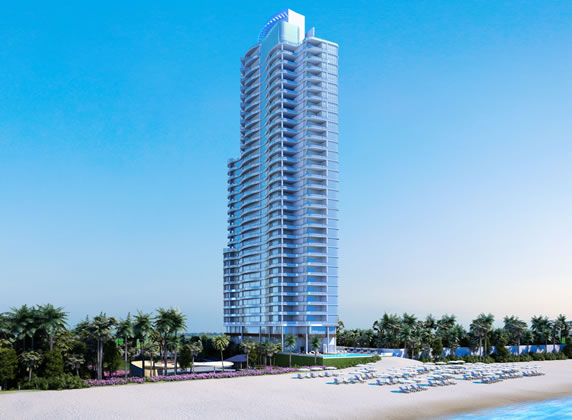
According to the developer, Château Beach’s flowing shape ensures that every one of its 84 residences offers breathtaking views of both the city and the Atlantic Ocean. Amenities will include a private restaurant, fitness center, cigar lounge, kids’ playroom, beach service and spa. Rendering courtesy Château Group
Great Expectations
Offsite property managers don’t typically go over well in a luxury high-rise setting, explains Campbell. At Campbell Management, all work orders and requests are managed by an onsite high-end manager who responds immediately. “The units can call down and make requests, and they’re handled as quickly as possible. They don’t have to call an offsite office in Miami or West Palm Beach.”
Staffing levels are also a crucial part of luxury high-rise facilities, explains Campbell. “Because these luxury buildings aren’t short-staffed, everything is taken care of in a very timely manner. Even in the generator rooms, you can literally see your face in the floor. Things are shiny and absolutely squeaky clean, just like Walt Disney World.”
Pomerantz says his team often designs infrastructure to support what tenants may want to include later. For example, automation systems that control window shades, lights, and home theater systems may not be included right away, but are systems that will likely be added later. To accommodate this, they’re often casting into concrete conduit runs to the windows so shade systems can be installed at a later date. Power distribution systems are set up in such a way that they can be centralized with dimming systems so that walls don’t have to be torn up later on. “You have to set them up so they can be customized for use later on. I don’t see too many developers wiring them that way ahead of time because you don’t know what your tenants are going to want.”
Changes in Luxury High-Rise Design
Hurricane Sandy not only affected the way New Yorkers look at electricity, but it changed the design of luxury high-rises. Gary Pomerantz, executive vice president at WSP Group, says his organization now considers the inclusion of a certain number of items in each unit that can run on partial standby power, such as a refrigerator, one light, and a few power outlets. The organization is also creating infrastructure that provides standby power for a few amenities within common areas to give tenants places to congregate if they’re stuck indoors.
Energy-efficient design has also altered the way luxury high-rises are designed and built. Because exterior walls no longer leak as much air as they used to, outdoor air systems are being installed in multifamily high-rises. “Clean, filtered, and temperature- and humidity-controlled air goes in, and now the kitchen exhaust, toilet exhaust, and clothes dryers really work.” But, as Pomerantz points out, these systems also require another degree of control. If a tenant’s clothes dryer runs for only two hours a week, excess air doesn’t need to be provided 24/7. Instead, controls bring in additional outside air only if the dryer or kitchen hood turns on. If you don’t bring in outdoor air, these systems won’t work.”
Leah Grout Garris
 An award winning editor, Leah spent over eight years in senior
editorial positions at both BUILDINGS magazine and ARCHI-TECH
magazine. Her work has been incorporated into training and
educational programs around the country. She is a graduate of
University of Iowa. She is Editor at Large for High Rise Facilities.
An award winning editor, Leah spent over eight years in senior
editorial positions at both BUILDINGS magazine and ARCHI-TECH
magazine. Her work has been incorporated into training and
educational programs around the country. She is a graduate of
University of Iowa. She is Editor at Large for High Rise Facilities.

